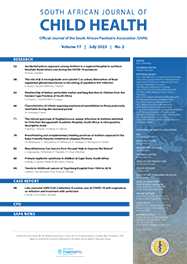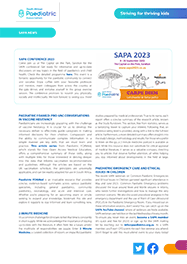Articles

Fracture patterns in non-accidentally injured children at the Red Cross Children’s Hospital
Abstract
Methods: The medical records of all children admitted between January 1991 and October 2005 were reviewed and children with fractures resulting from non-accidental injury (NAI) were included in the study.
Results: During the 14-year study period, 99586 trauma patients were treated at RXH, of which 1037 (1.04%) were diagnosed with non-accidental injury. The majority was male (64%). An the average age was 44.8 months. Of the 1037 patients diagnosed with NAI, 121 (11.7%) sustained a total of 149 fractures; 21 (17.3%) with multiple fractures (16 had 2 fractures, 3 had 3 fractures and 2 had 4 fractures). The head and neck was the most frequently fractured anatomical area (53%), followed by the upper limb (24%) and lower limb (18%). Only 7 fractures of the trunk were seen. Children sustaining fractures of the head and neck were significantly younger than those sustaining fractures to other areas.
Discussion: Although the established consensus on fracture patterns in NAI is that long bone fractures are the most frequently experienced in clinical practice, the principal finding of our study was that skull fractures were considerably more common; nearly 40% of all fractures were skull fractures. Skull fractures were associated with violent injury; approximately one-third were reported to have been inflicted with an implement/weapon and one-quarter of these children had multiple fractures at the time of presentation. This underlines the importance of local studies, as socio-cultural issues underpin many of the aetiological factors related to disease burden in general, and to child abuse in particular.
Authors' affiliations
Arjan Bastiaan van As, Prof
Richard Craig,
James M Franklin,
Sudeshni Naidoo, Prof
Full Text
Keywords
Cite this article
Article History
Date published: 2007-11-26
Article Views
Full text views: 3138

.jpg)



Comments on this article
*Read our policy for posting comments here